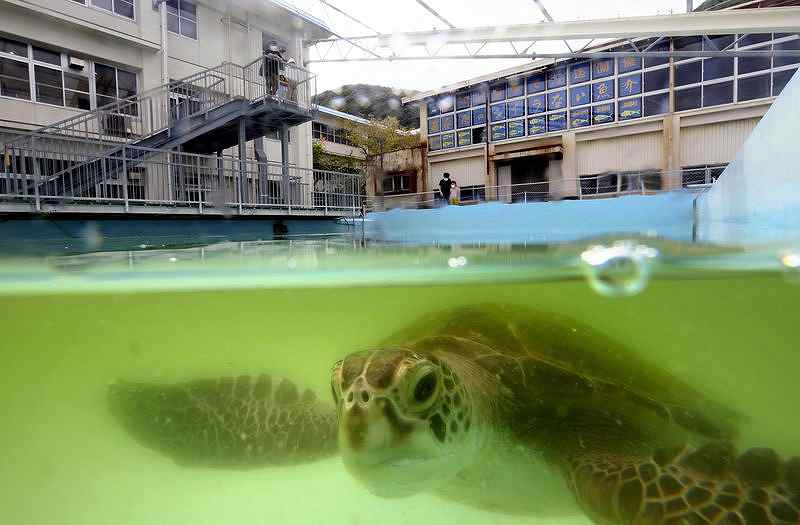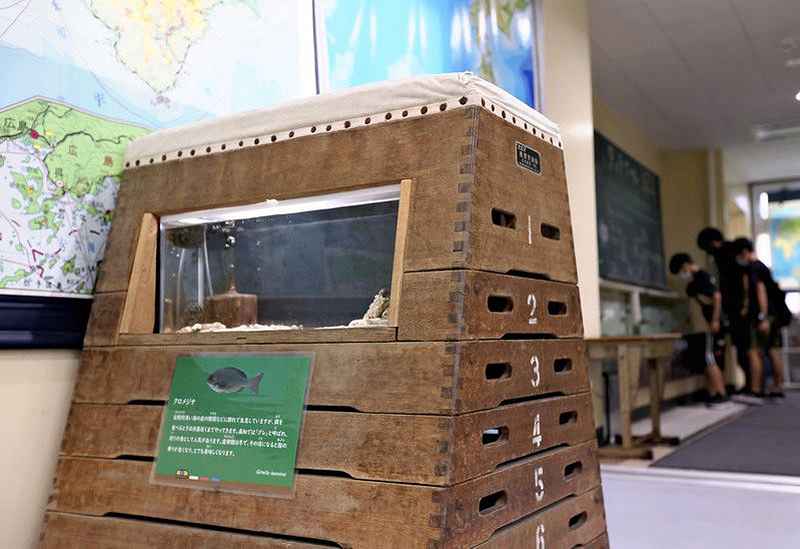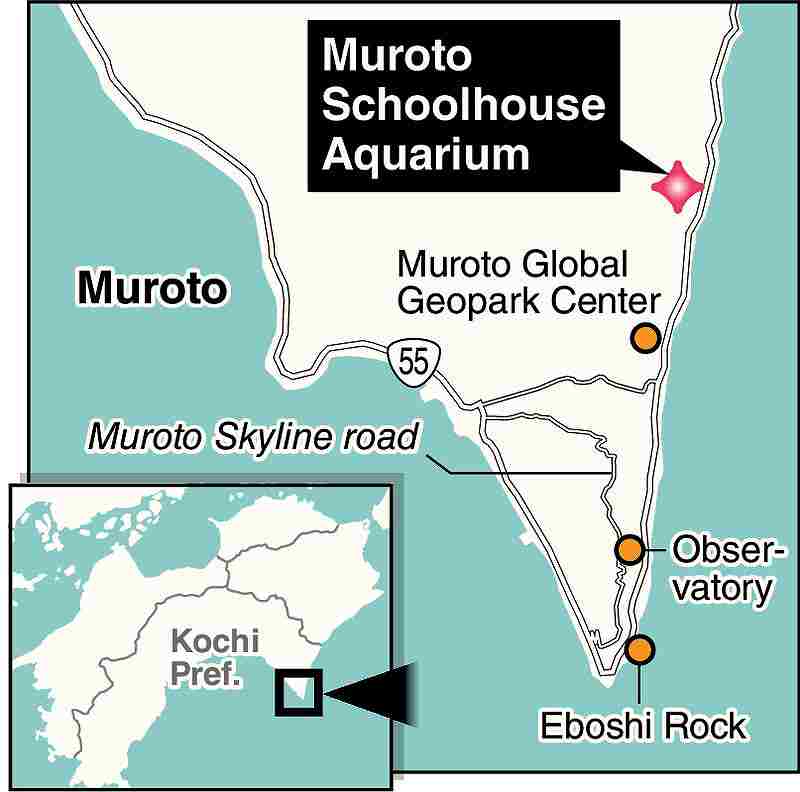
A sea turtle swims in a former elementary school pool at the Muroto Schoolhouse Aquarium in Muroto, Kochi Prefecture.
November 7, 2021
MUROTO, Kochi — An aquarium made creatively from the existing buildings, facilities and other parts of a shuttered elementary school is attracting people to a city on the southeastern tip of Shikoku.
The Muroto Schoolhouse Aquarium was established on the site of the former Shiina Elementary School on the Muroto Peninsula in the city of Muroto, Kochi Prefecture.
The aquarium does not feature the star animals such as penguins and dolphins that are popular at other aquatic facilities, because the operator has a limited budget. However, the imaginative setting attracts visitors precisely because it lacks the slick, stylish facilities of typical aquariums.
Muroto Schoolhouse Aquarium is now so renowned that many people queue at the entrance on weekends and holidays.

Visitors can see and touch sea cucumbers and hermit crabs in a pool that used to be a schoolhouse sink.
Swimming pool for turtles
A sea turtle raised its head above the water’s surface to take a breath. Seeing this, a child joyfully shouted, “A turtle opened its mouth!”
In addition to turtles, about 10 fish species — including horse mackerel and white-spotted parrotfish — live in the 25-meter-long outdoor pool. The animals are so close that children can almost touch them.
An ordinary swimming pool for elementary school kids has been transformed and is now a platform for powerful experiences that cannot be had through thick glass walls.
The aquarium opened in 2018 and is operated by the Sea Turtle Association of Japan, a nonprofit that researches sea turtles in Muroto and elsewhere.
After the city-run elementary school was closed, the buildings remained vacant. But now the NPO makes use of typical schoolhouse items to house exhibits, giving the aquarium a school-like atmosphere.
A sink where children used to wash their hands has been converted into a pool for sea cucumbers, hermit crabs and other creatures, which visitors can touch.
Small aquariums fill former classrooms and a science study room. After some reworking, even a gymnastics vaulting box houses a water tank.
Neither rare nor precious fish are exhibited. Rather, familiar species are on display, including striped mullet, stone fish, moray eel and goldfish. Yet all of them are perfect for Instagram photos.
Even empty tanks get special treatment. For example, one tank whose exhibit was being changed had a note attached stating, “Currently reassigning students,” eliciting laughter from visitors.
“This place has the atmosphere of a school festival,” said a 28-year-old man from Takamatsu. “Even though the fish are ordinary, the way they are displayed makes it worth a visit.”

An aquarium is embedded in a gymnastics vaulting box.
Betting on ideas
Motoki Wakatsuki, the director of the Sea Turtle Association of Japan, was the driving force behind the aquarium and became its head.
The NPO had collected more than 1,000 specimens during research activities and was looking for a place to display them. In 2014, the group learned that Muroto was looking for ways to utilize a shuttered school.
Wakatsuki offered to exhibit the specimens at the school and keep sea turtles — including ones rescued from fishing nets — in the swimming pool. Wakatsuki’s proposal morphed into the idea of turning the school into an aquarium, and the city government refurbished the site at a cost of ¥550 million.
However, the municipality is not saddled with the operating costs. Wakatsuki aims to have the facility financed solely by admission fees and merchandise sales.
The aquarium does not have large animals whose feeding costs are high. Rather, the NPO asks fishermen to donate fish caught in their nets, and aquarium staff themselves collect specimens by catching them in the sea.
The interior of the aquarium also shows the staff’s ingenuity. For example, the water tank purification units were made from parts purchased at DIY stores and assembled by the staff.
“If we needed professionals from Tokyo to fix things whenever something breaks, the facility would go broke,” Wakatsuki said. “If it can’t be maintained by our staff of seven or so, we don’t install it.”
The aquarium holds a kakizome event — the first calligraphy writing of the New Year — on Jan. 1 every year, except it uses squid ink instead of normal ink. It also holds pool-cleaning events with students on school trips. Such innovative ideas add to the facility’s popularity.

Eboshi Rock
Knock-on effect
The aquarium saw about 170,000 visitors in its first year, a figure almost equaling the annual number of people who go to the Sakamoto Ryoma Memorial Museum in Kochi City. Hailing from Kochi, Sakamoto was a key figure in the Tokugawa shogunate’s final years. Due to his popularity, history buffs from all over Japan visit the museum.
Many people visited the Muroto aquarium during the spring Golden Week holiday this year. It ranked sixth among Kochi Prefecture tourist destinations in visitor numbers, drawing in more people than the Katsurahama Aquarium, which has popular sea lion shows.
Muroto Peninsula has various tourist spots, such as observatories with panoramic views of the Pacific Ocean and a geopark with many fantastic rock formations. The aquarium likely has a positive impact on such destinations.
The aquarium has a fortune-telling vending machine, similar to ones at Shinto shrines. With my work done, I decided to give it a go.
Unfortunately, my fortune was not so good. However, it also said: “Drive along the Muroto Skyline road and experience the Earth from views of the Pacific Ocean and coastal terraces.” I followed the divination and drove home, enjoying the scenery and sea breeze.
How to get there
The Muroto Schoolhouse Aquarium is a 90-minute drive from Kochi Airport, or a two-hour drive from Kochi City. Admission fees are ¥600 for high school students or older, and ¥300 for elementary and junior high school students. The aquarium is open year-round. The Muroto Global Geopark Center, which is a five-minute drive from the aquarium, explains how the Muroto Peninsula was formed.

Extend your trip!
Eboshi Rock
Eboshi Rock is a massive gabbro in a geopark formed 14 million years ago when magma slowly cooled and solidified. Tectonic shifting pushed Cape Muroto upward, bringing Eboshi Rock to the surface from the seabed. Its name comes from traditional headwear called eboshi, which was part of the formal attire worn by aristocratic men.
The city of Muroto has been designated as a UNESCO Global Geopark, and in its coastal areas, visitors can see uniquely shaped rocks and traces of past crustal movement.
"Society" POPULAR ARTICLE
-

M4.9 Earthquake Hits Tokyo, Neighboring Prefectures
-

M7.5 Earthquake Hits Northern Japan; Tsunami Waves Observed in Hokkaido, Aomori and Iwate Prefectures
-

Tsukiji Market Urges Tourists to Avoid Visiting in Year-End
-

Israeli Tourists Refused Accommodation at Hotel in Japan’s Nagano Pref., Prompting Protest by Israeli Embassy and Probe by Prefecture
-

M5.7 Earthquake Hits Japan’s Kumamoto Pref., Measuring Upper 5 Intensity, No Tsunami Expected
JN ACCESS RANKING
-

Keidanren Chairman Yoshinobu Tsutsui Visits Kashiwazaki-Kariwa Nuclear Power Plant; Inspects New Emergency Safety System
-

Imports of Rare Earths from China Facing Delays, May Be Caused by Deterioration of Japan-China Relations
-

University of Tokyo Professor Discusses Japanese Economic Security in Interview Ahead of Forum
-

Japan Pulls out of Vietnam Nuclear Project, Complicating Hanoi’s Power Plans
-

Govt Aims to Expand NISA Program Lineup, Abolish Age Restriction























